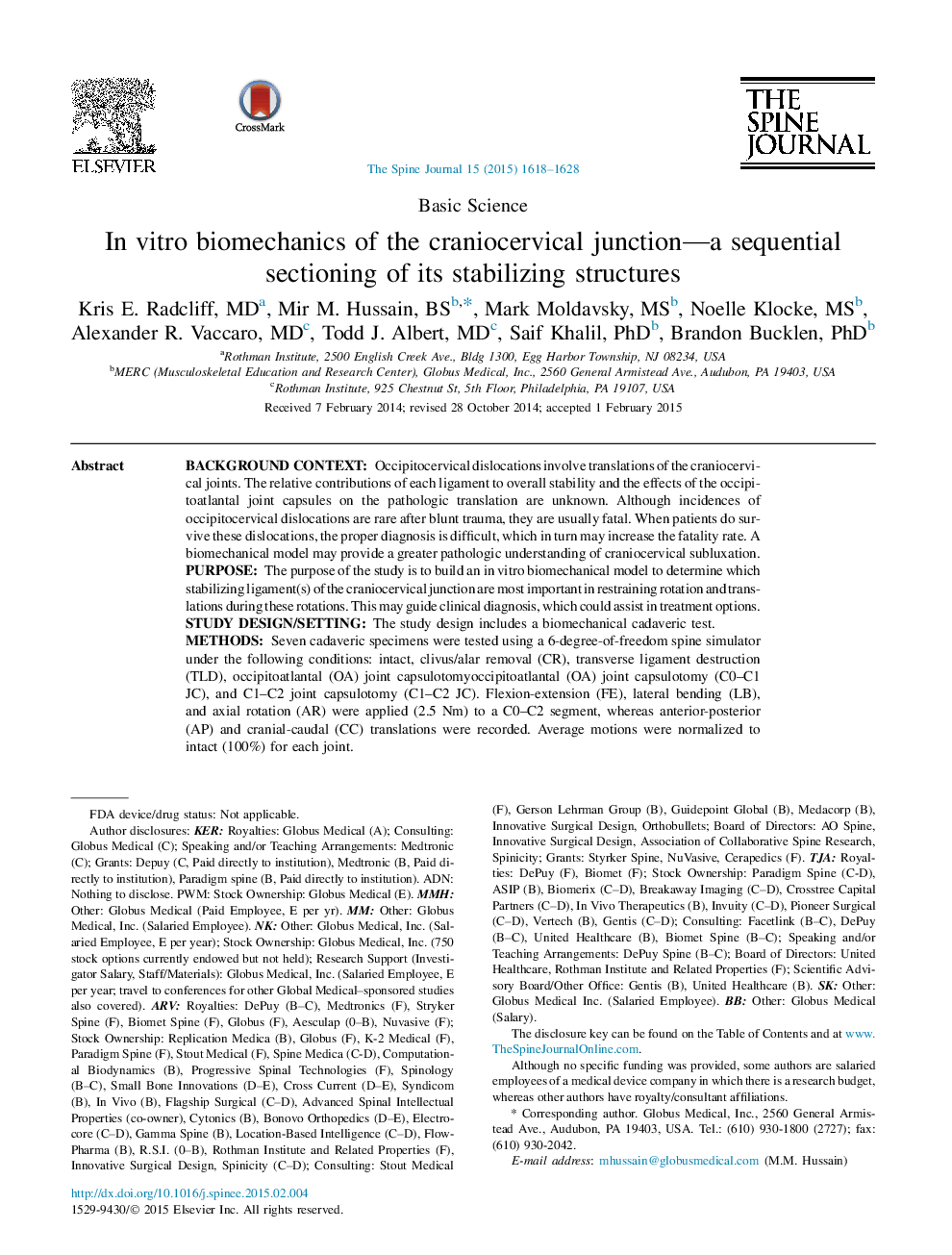| کد مقاله | کد نشریه | سال انتشار | مقاله انگلیسی | نسخه تمام متن |
|---|---|---|---|---|
| 4096076 | 1268551 | 2015 | 11 صفحه PDF | دانلود رایگان |

Background contextOccipitocervical dislocations involve translations of the craniocervical joints. The relative contributions of each ligament to overall stability and the effects of the occipitoatlantal joint capsules on the pathologic translation are unknown. Although incidences of occipitocervical dislocations are rare after blunt trauma, they are usually fatal. When patients do survive these dislocations, the proper diagnosis is difficult, which in turn may increase the fatality rate. A biomechanical model may provide a greater pathologic understanding of craniocervical subluxation.PurposeThe purpose of the study is to build an in vitro biomechanical model to determine which stabilizing ligament(s) of the craniocervical junction are most important in restraining rotation and translations during these rotations. This may guide clinical diagnosis, which could assist in treatment options.Study design/SettingThe study design includes a biomechanical cadaveric test.MethodsSeven cadaveric specimens were tested using a 6-degree-of-freedom spine simulator under the following conditions: intact, clivus/alar removal (CR), transverse ligament destruction (TLD), occipitoatlantal (OA) joint capsulotomyoccipitoatlantal (OA) joint capsulotomy (C0–C1 JC), and C1–C2 joint capsulotomy (C1–C2 JC). Flexion-extension (FE), lateral bending (LB), and axial rotation (AR) were applied (2.5 Nm) to a C0–C2 segment, whereas anterior-posterior (AP) and cranial-caudal (CC) translations were recorded. Average motions were normalized to intact (100%) for each joint.ResultsIncreases in C0–C1 angular and translational motions occurred after TLD and C0–C1 JC. At the atlantoaxial joint, there were significant (p<.05) increases from intact in FE (TLD=154%, C0–C1 JC=174%) and in AR (TLD=178%, C0–C1 JC=224%). Anterior-posterior translation during applied LB increased significantly after TLD (248% intact). Cranial-caudal translation during applied FE increased significantly after TLD (188%) and C0–C1 JC (361%). Increases in C1–C2 angular motion occurred after TLD and C1–C2 JC and in translation after CR and TLD. At the C1–C2 joint, there were significant increases from intact in FE (TLD=172%, C1–C2 JC=160%) and in LB (TLD=286%, C1–C2 JC=332%); in AR, there were no statistical differences. Anterior-posterior translation increased significantly after CR (280%). Cranial-caudal translation also increased significantly after CR (205%) and TLD (298%) during LB.ConclusionsTransverse and alar ligaments appear to be the main stabilizers of the craniocervical junction. The vertical structures attached to the clivus and OA joint capsules function as secondary stabilizers. Craniocervical dislocations seem to affect FE and lateral bending the most, whereas increased translation seems to occur primarily in the AP and CC directions. Models of craniocervical trauma should section all three restraining structures for the future studies.
Journal: The Spine Journal - Volume 15, Issue 7, 1 July 2015, Pages 1618–1628